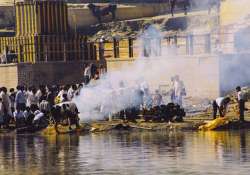NGT questions Hindus' cremation procedure, says it causes air, water pollution
New Delhi: The National Green Tribunal (NGT) has questioned the centuries-old tradition practised by Hindus to cremate dead bodies at the river banks, saying the method of burning wood leads to air pollution and also

New Delhi: The National Green Tribunal (NGT) has questioned the centuries-old tradition practised by Hindus to cremate dead bodies at the river banks, saying the method of burning wood leads to air pollution and also effects natural water resources.
Keeping in mind the growing level of pollution, the NGT said that there was a need to adopt environment-friendly methods like electric crematoriums and use of CNG and change the 'mindset of the people'.
The NGT bench headed by Justice UD Salvi also directed the Union Environment Ministry and the Delhi government to initiate programmes to provide alternative modes of cremation of human remains, saying the traditional emitted hazardous pollutants in the environment.
Also Read: Why women are not allowed at shamshan ghat?
"The issue involves question of faith and circumstances in which the people live, it is, therefore, the responsibility of the men who lead, particularly religious leaders, to steer the faith in a direction so as to change the mindset of people practising their faith and make them adopt practices which are environment-friendly," the bench observed while directing authorities, including civic bodies, to educate the public in this regard.
"It is also the responsibility of the government to facilitate the making of the mindset of the citizens as well as to provide environment-friendly alternatives for cremation to its citizenry," the bench further said.
The green panel said the traditional means of cremation caused adverse impact on environment and dispersal of ashes in the river led to water pollution.
"Religions of the world, therefore, conceived of different methods for disposal of the dead on the basis of their theology and the circumstances in which the believers lived. Where there was plenty of wood, the individuals thought of disposal of their dead by burning with wood, but where there was scarcity of wood the individuals buried their dead," it said.
In Hinduism, the cremation ground (shmashana ghat) is located near a river, if not on the river bank itself. According to tradition, a dead body is washed by family members in the river water before being put on wood pyre with feet facing south. It is said that Hindus believe that soul of a dead person must be completely detached from the body to attain 'moksha'. And for this, an open cremation is needed so that the soul can be released easily as soon as the body is set on fire. The ashes are later immersed in the river completing the rite.
The NGT was hearing a plea by advocate DM Bhalla who had said that cremation of humans by conventional methods added to air pollution, therefore, alternative modes of cremation needed to be used.
Bhalla contended that cremation of human remains by traditional method involving wood has serious impact on the environment as 'the forest cover is sacrificed and obnoxious gases emanated from the burning of human mortal remains pollute the air'.
With Agency Inputs